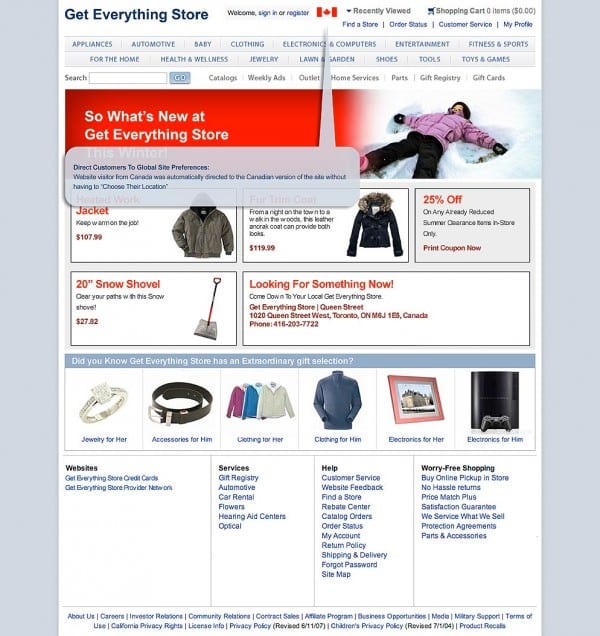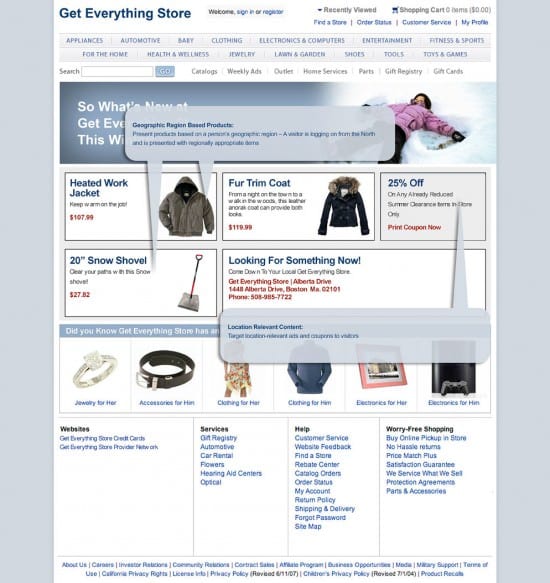Dispelling 7 'marketing limiting' myths about IP geolocation
 IP geolocation technology has been around for more than 13 years. It is used across the globe for a variety of purposes, one of the foremost being marketing.
IP geolocation technology has been around for more than 13 years. It is used across the globe for a variety of purposes, one of the foremost being marketing.
And yet, an aura of mystery still surrounds what IP technology is and what it can do. IP also has a slightly tarnished reputation in some companies; usually as a result of IP data providers supplying data that fails to meet expectations, leaving companies disillusioned with the technology’s business potential.
This article aims to dispel some common misconceptions on the use of geolocation data, including the way data is derived. The objective is to help marketers understand this technology's true potential, which is increasing in an increasingly location-based digital world.
IP geolocation explained
IP geolocation is an extremely powerful technology that can make a tremendous difference to any organisation’s ability to connect with its online audience. It’s important to fully understand some of the major differences between solutions and realise that not all IP data providers are created equal.
IP geolocation technology makes it possible to establish the physical location and connection attributes of visitors to your website based on their IP address. It lets publishers, ecommerce sites, ad networks and others serve content tailored to the user’s locations at the most relevant moment.
One of the advantages of using IP geolocation is the information it provides is not linked to an identified individual, honouring individual anonymity. As an approach, it’s particularly valuable at a time when we're all anxious about consumer perceptions of potentially invasive data-collection techniques, such as cookies,
You will already be familiar with the use of IP geolocation to identify visitors from a country; an approach adopted by Amazon and the BBC. Here is a generic retail example:
 Some retailers also use geographic region related products and content:
Some retailers also use geographic region related products and content:
 Now let’s dispel some common myths about IP geolocation…….
Now let’s dispel some common myths about IP geolocation…….
Myth 1: IP-based targeting isn’t accurate enough in my country
Many IP providers, such as Whois, rely heavily on publically available (free) registration data. This data is notoriously inaccurate at a city-level, typically less than 50%. Even at country-level, where there are coverage gaps due to no results being returned, ommissions can be higher than 20 to 30%.
The reasons for this are:
- Whois IP registration is voluntary for Internet Service Providers (ISPs).
- Most ISPs register their entire allocated IP block to their corporate headquarters address, rather than to the end user to whom the IP is assigned.
In fact:
Alternative more accurate technology solutions use web spidering and other methods to triangulate geolocation, connection speed, and other characteristics associated with an IP address; collectively referred to as IP Intelligence.
In addition, ‘inside-out’ infrastructure analysis is combined with ‘outside-in’ user location feedback, gleaned from a network of partners, to improve and validate response down to a hyperlocal city/postcode level. Cross-referencing these diverse data creates sophisticated targeting, allowing internet access linked to the ISP’s end-point equipment, rather than the ISP’s headquarter location.
This advanced approach creates high levels of accuracy worldwide - up to 99.99% accurate at a country-level and 97% at a city-level.
The most advanced technologies produce results for 99.99% of all the IP addresses companies, allowing you to maximise the traffic you geo-target.
Myth 2: IP-based targeting is not as accurate as other forms of targeting
There are certainly non-IP-based geolocation technologies that provide more granular location information on small slices of the Internet using techniques such as user-provided registration data, cookies, GPS latitude/longitude, or HTML5.
However, these techniques are far from comprehensive:
- User-supplied location information is only helpful to the extent that a user agrees to provide it. Even when they do, it’s not always accurate.
- Cookies logged on a user’s machine allow sites to store previously entered location information. However, this is subject to a user providing location information and the cookie remaining undeleted. And cookies are increasingly under fire for being invasive.
- GPS location information can be accurate within a few feet but it’s based on application, rather than browser; and it requires user permission to retrieve and deploy via a smart GPS-enabled device.
- HTML5 derives location information from some of these sources but it is opt-in per session. Thus each web visitor must provide permission to access this level of personally identifiable detail, meaning HTML5 is very limited in terms of reaching an addressable audience.
In fact:
Geolocation technologies exist that provide a comprehensive non-personally identifiable view of a user’s location within a 3 to 5 mile radius for virtually the entire Internet. Targeting by IP addresses is ideal for reaching broad audiences without the need to track individuals and their behaviours online. IP addresses are particularly accurate in reaching audiences based on their place and context of access to the Internet―such as postcode geography, home/business, company name, and connection type.
Myth 3: You must rely on ISPs to get IP geolocation data
ISPs are notoriously lax in keeping up-to-date IP address location information in their registries. Most either don’t report location information in the Whois registries or only report their corporate headquarters’ address. With 2 to 5% of IP addresses changing on a monthly basis, ISPs simply have no commercial reason to maintain a consolidated up-to-date database.
In fact:
IP geolocation providers that use web spidering technology can trace how traffic is routed over the Internet, how routers are connected and the speed between routers. They then use this information to triangulate the location of end-point equipment, enabling them to target where each user is actually accessing the Internet.
Myth 4: Because IP addresses are dynamic, it’s impossible to provide accurate geolocation information
Most IP addresses are dynamically allocated to some extent. Dynamic IP allocation is a very real problem for providers who rely on ISP/Whois registration information.
In fact:
The most innovative solutions base their mapping on the location of known pools of dynamic IPs. ISP dynamic re-allocations tend to be within these known IP address pools. And the geographic allocation of pools actually remains fairly constant at the ISP end-point equipment level.
Additionally, providers with extensive customer networks are able to pick up IP address re-allocations across pools the instant they occur and can ensure that data remains current and accurate. As such, dynamic re-allocations do not affect solution accuracy.
Myth 5: IP-based geolocation has no role in the mobile space
In most instances, in order for marketers to take advantage of location-based services, mobile users must opt-in to GPS tracking applications on their devices. However, a large percentage of mobile device users choose not to opt-in to location-based services. What happens, then, to these people?
In fact:
 Marketers can still successfully reach these users “on the go” with IP-based geolocation technology by targeting mobile users by location as they move between wireless and WiFi networks. Generally, Internet traffic is either wired PC-based, WiFi-based mobile device and PC, or cell tower-based mobile device.
Marketers can still successfully reach these users “on the go” with IP-based geolocation technology by targeting mobile users by location as they move between wireless and WiFi networks. Generally, Internet traffic is either wired PC-based, WiFi-based mobile device and PC, or cell tower-based mobile device.
IP geolocation data enables you to accurately target the first two connectivity types (wired and WiFi) as these are fixed points-of-presence on the publically routable Internet. Because WiFi connections represent more than 80% of mobile Internet device traffic in terms of page views, most mobile device traffic can be accurately targeted using IP geolocation. In short, IP geotargeting can target virtually 100% of traditional wired traffic and more than 80% of mobile device traffic.
Because pure cell tower-based IP connections traverse wireless carriers’ private cellular networks, they are not traceable until the wireless signal is connected and converted to the publically routable wired Internet; generally at regionalised POP locations.
The distribution of POP locations varies widely across wireless providers. For this reason, targeting mobile IPs is different (e.g. at a country-level only) from the vast remainder of the IP space, which is location-targetable at a city/postcode level.
Myth 6: IP addresses are considered personally identifiable information (PII)
EU data privacy laws have consistently held that an IP address in and of itself is not personal data, but that an IP address can become personal data when combined with other information or when used to build an individual’s profile. If IP addresses in and of themselves were considered PII, we wouldn’t have routers or Whois registries. It’s only the collection and sharing of IPs that implicates PII.
In fact:
Technology that gleans geolocation data solely from network infrastructure analysis of ISP nodes, not from user interactions, ensures no PII is ever collected or stored. By using the location of these ISP nodes as a proxy for actual IP address location, these technologies are generally able to isolate end-user location within a 3 to 5 mile radius, or across approximately 1,000 to 2,000 households.
Because this methodology relies purely on analysis of network infrastructure, individuals’ web behaviours are not monitored, cookies are never installed on users’ machines and no PII, such as name or address, is ever collected or stored.
Myth 7: Premium IP intelligence solutions are expensive
There are a number of lower-end vendors operating as entry-level geolocation providers. However, as companies find they need more breadth, depth and accuracy in targeting data, these solutions are unable to deliver the true business value IP Intelligence offers.
In fact:
Leading industry providers understand the unique online marketplace and offer flexible pricing to meet the needs of both large and small organisations. Pricing is often scalable so changing needs can be addressed cost-effectively.
You can derive greater value from providers that offer accuracy, reliability, variety and granularity in IP Intelligence data. In general, marketers can expect to achieve significant ROI on their investment due to:
- 30 to 300% increases in response rates to geo-targeted content
- Web visitors are six to seven times more likely to convert when content is localised
- Geo-targeted impressions sell for a 30 to 50% premium over untargeted impressions
Case example: Alterian gains actionable insight from NetAcuity® geolocation data
Alterian, a leader in campaign management and social analytics, incorporated geolocation data into its technology platform to better understand customer behaviour and derive more actionable insights for its customers.
Alterian chose NetAcuity®, Digital Element’s flagship geolocation technology, because of its reliability, accuracy and technology attributes, such as the ability to target to a city or postcode level.
“NetAcuity provides our WebJourney service with the actionable intelligence needed for comprehensive customer engagement management. Alterian customers can focus on the individual experience utilizing IP data to better segment users in the future or drive visitors to specific content that is more relevant to them.”
Rusty Warner, Vice President of Product Marketing, Alterian
NetAcuity has enabled Alterian to:
- Guarantee its clients high-value engagement based on insight-driven analytics
- Treat customers consistently across channels
- Measure the business impact of marketing activities.
Here are key benefits from using geolocation technology gained by some of Alterians’ customers:
- A global hotel chain realized 40% increase in click-through rates, 540% rise in loyalty point redemption and 30% overall return on investment.
- An electronics retailer in Asia benefited by better defining content for optimal purchase sessions, developing up-sell and cross-sell campaigns and establishing follow-up actions based on customer behaviour.
- A major Australian bank achieved reduced direct marketing costs, creation of new cross-sell opportunities and increased campaign response rates and conversions.

Thanks to
Kate Owen for sharing her advice and opinions in this post. Kate serves as Managing Director, Europe for
Digital Element, bringing over twelve years of technology solutions and online advertising experience to her role. Prior to Digital Element, Kate spent twelve years living and working in Germany, initially in product management roles for digital publishing brands, and later heading up Business Development for the advertising network ad pepper media. In 2010 she moved to London to lead UK operations for the ad serving company Emediate . You can follow her on
Twitter or connect on
LinkedIn.







 Thanks to
Thanks to 


